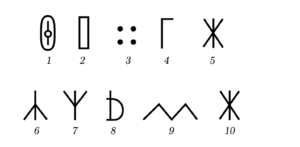The Dogon of Mali are well-known for their elaborate and complex religious traditions, involving mask dances, which are worth an Atlas of their own. For our purposes, we’ll simply point out that, according to Jason Glavy and Andrij Rovenchak, a range of symbols have been used by Dogon shamans in sorcery rituals: the symbols were drawn on sand and then a prediction was read from the jackal tracks.

Figure 0.5: Dogon signs (upper row): 1 — a man’s garment (bubu); 2 — a woman’s garment (skirt); 3 — the jackal, or any quadruped; 4 — an axe; Bambara signs (bottom row): 6 — woman, female principle; 7 — man, the male, the masculine principle; 8 — shadow, image, also used for the ja (dya) or immaterial double of a human being (a soul?); 9 — the sun’s movement, the year. Signs 5, 10 mean ‘world, Universe’ in both systems [Zahan 1950].
This entry is what Wikipedia calls a “stub”–that is, we know very little, we wish we knew more, and we’d love to hear from anyone who can add to our sad little stub of knowledge.
14.6338° N, 3.4196° W